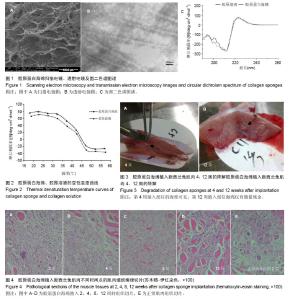| [1] 顾其胜,严凯.胶原蛋白在组织工程及临床中的应用[J].上海生物医学工程,1999,20(3):35-38.
[2] 丘敏梅,易石坚,何大源,等.医用胶原蛋白海绵治疗重度肝破裂的临床研究[J].中国医药导报,2006,3(23):36-38.
[3] 唐尚权,徐新华.胶原蛋白海绵在腰椎间盘突出手术中的止血作用[J].中国医药指南, 2012,10(9):31-32.
[4] 廖洪斐,高桂平,刘静,等.胶原蛋白海绵作为多孔羟基磷灰石义眼台眶内植入包裹材料的可行性[J].中国组织工程研究与临床康复,2008,12(23):4531-4533.
[5] 张安美.凝血酶与胶原蛋白海绵联合用于手术创面止血的临床应用观察[J].潍坊医学院学报,2013,35(1):22-25.
[6] 卫秀洋,王万明,陈勇忠,等.胶原蛋白海绵复合bFGF促进兔胫骨外露创面愈合的实验研究[J].中国医药指南, 2012,10(23):399-401.
[7] 田波,刘慧雯,于宏伟,等.大鼠胎脑神经细胞与几丁质多孔体、胶原蛋白海绵及明胶海绵生物相容性的实验研究[J].哈尔滨医科大学学报,2003,37(1):10-12.
[8] 魏敏,刘开军,刘杰,等.利用牛胶原构建人工真皮[J].中国临床康复,2003,7(11):1634-1635.
[9] 骆凯,闫福华,金岩,等.牛肌腱复合胶原与人牙周膜成纤维细胞培养的实验研究[J].中国修复重建外科杂志,2005,19(3):234-237.
[10] Miltyk W,Palka JA.Potential role of pyrroline 5-carboxylate in regulation of collagen biosynthesis in cultured human skin fibroblasts.Comp Biochem Physiol A Mol Integr Physiol. 2000; 125(2):265-271.
[11] 徐俊华,王慧明.牛肌腱胶原蛋白的提取及多孔支架的制作[J].中国口腔种植学杂志, 2005,10(3):108-110.
[12] 郝岱峰,李涛,冯光,等.胶原蛋白海绵人工真皮在皮肤鳞状细胞癌创面修复中的应用[J].中国美容医学,2013,22(1):96-97.
[13] 陈国会.胶原蛋白海绵预防拔牙创口干槽症的效果观察[J].临床合理用药杂志, 2012,5(15):113.
[14] 蔡敏倩,王晓杰,李校堃.胶原蛋白海绵的性质及其临床应用[J].中国组织工程研究与临床康复,2011,15(12):2270-2274.
[15] 张立彦,芮汉明,张玲.制备条件对壳聚糖/胶原蛋白海绵敷料性能的影响[J].化工进展, 2011,30(2):390-395.
[16] 王秋卓.牛跟腱制造海绵状胶原蛋白纤维的技术研究[J].中国医药生物技术, 2011,6(4):305-306.
[17] 汪海婴,梁艳萍,李云雁,等.鱼源胶原蛋白海绵材料的构建及其生物学性能[J].华中科技大学学报:医学版,2012,41(6):709-715.
[18] 马忠仁,冯玉萍,李明生,等.新生牛皮胶原蛋白海绵的制备及其体外细胞相容性[J].中国组织工程研究与临床康复, 2007,11(26): 5147-5150.
[19] 方成,汪海波,梅智强,等.鱼皮胶原蛋白海绵组织相容性的体内实验研究[J].中国生物医学工程学报,2014,33(2):212-217.
[20] Ueda H,Hong L,Yamamoto M,et al.Use of collagen sponge incorporating transforming growth factor-beta1 to promote bone repair in skull defects in rabbits. Biomaterials. 2002; 23(4):1003-1010.
[21] 成洪泉,翦新春,许春娇.胶原海绵与骨髓基质成骨细胞体外联合培养的实验研究[J].口腔医学研究,2004,20(5):498-500.
[22] Woolfson DN,Ryadnov MG.Peptide-based fibrous biomaterials: Some things old, new and borrowed.Curr Opin Chem Biol.2006;10(6):559-567.
[23] Fields GB.The collagen triple-helix: correlation of conformation with biological activities.Connect Tissue Res. 1995;31(3):235-243.
[24] Anselme K,Bacques C,Charriere G,et al.Tissue reaction to subcutaneous implantation of a collagen sponge.A histological, ultrastructural, and immunological study.J Biomed Mater Res.1990;24(6):689-703.
[25] Yang L,Fitie CF,van der Werf KO,et al.Mechanical properties of single electrospun collagen type I fibers. Biomaterials. 2008; 29(8):955-962.
[26] Tiffany ML,Krimm S.Effect of temperature on the circular dichroism spectra of polypeptides in the extended state. Biopolymers.1972;11:2309-2316.
[27] 张之宝,王静洁,陈晖娟,等.圆二色谱研究胶原模拟多肽三螺旋结构及其热稳定性[J].光谱学与光谱分析,2014,24(4):1050-1055.
[28] 钟朝辉,李春美,顾海峰,等.温度对鱼鳞胶原蛋白二级结构的影响[J].光谱学与光谱分析,2007,27(10):1970-1976.
[29] Usha R,Ramasami T.The effects of urea and n-propanol on collagen denaturation: using DSC, circular dicroism and viscosity.Thermochimica Acta.2004;409:201-206.
[30] Long CG,Braswell E,Zhu D,et al.Characterization of collagen-like peptides containing interruptions in the repeating Gly-X-Y sequence.Biochemistry. 1993;32(43):11688-11695.
[31] 段蕊,叶超,邢芳芳,等.采用圆二色谱法研究冬夏鲢鱼鳞胶原蛋白的稳定性[J].食品与发酵工业,2010,36(1):73-76.
[32] Ukegawa M,Bhatt K,Hirai T,et al.Bone marrow stromal cells combined with a honeycomb collagen sponge facilitate neurite elongation in vitro and neural restoration in the hemisected rat spinal cord.Cell Transplant.2014.[Epub ahead of print]
[33] Varga M,Sixta B,Bem R,et al.Application of gentamicin-collagen sponge shortened wound healing time after minor amputations in diabetic patients - a prospective, randomised trial.Arch Med Sci.2014;10(2):283-287.
[34] Koo KH,Ahn JM,Lee JM,et al.Apatite-Coated Collagen Sponge for the Delivery of Bone Morphogenetic Protein-2 in Rabbit Posterolateral Lumbar Fusion.Artif Organs.2014.doi: 10.1111/aor.12249. [Epub ahead of print] |

